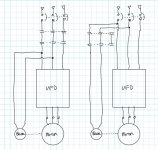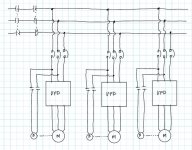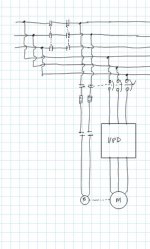We have an existing VSD where a three phase circuit breaker feeds the drive, and two phases also tee off to a contactor, which is energised to release the brake.
Currently if a safety circuit is tripped, redundant safety contactors remove the three phase supply, which (a) removes power from the VSD, and (b) removes power from the brake. This means that under emergency stop conditions, the motor is stopped and the brake is engaged. This is important as the load is a high inertia load with lots of sharp things on it.
The VSD is now being changed from a powerflex 40 on DeviceNet, to a Powerflex 525 on Ethernet. Removing power from the drive due to emergency stop is not desired due to (a) shortening the lifespan of the drive, and (b) a loss of communication every time this occurs (exacerbated because this replacement covers ~20 drives in a DLR loop across multiple safety zones
So, we will make the three phase supply to the drive non-isolated, and use safe torque off. However, the supply to the brake still needs to be isolated by safety contactors under emergency stop conditions, to ensure that the brake engages on e/stop.
My concern is that currently, one circuit breaker removes power to all motor wiring (windings via VSD, and brake via contactor), but if I can't tee the brake off the drive circuit breaker any more, I'll need a separate circuit breaker for the brake, and there's no longer a single isolation point for that motor.
How do you folks handle this? Do five-pole breakers exist somewhere? Do linking kits exist so that I could mechanically link a three pole breaker with a two pole breaker mounted next to it? The motor itself has a six-pole isolator (three phases, brake, and PLC feedback), but I don't know what to do at the MCC side.
Currently if a safety circuit is tripped, redundant safety contactors remove the three phase supply, which (a) removes power from the VSD, and (b) removes power from the brake. This means that under emergency stop conditions, the motor is stopped and the brake is engaged. This is important as the load is a high inertia load with lots of sharp things on it.
The VSD is now being changed from a powerflex 40 on DeviceNet, to a Powerflex 525 on Ethernet. Removing power from the drive due to emergency stop is not desired due to (a) shortening the lifespan of the drive, and (b) a loss of communication every time this occurs (exacerbated because this replacement covers ~20 drives in a DLR loop across multiple safety zones
So, we will make the three phase supply to the drive non-isolated, and use safe torque off. However, the supply to the brake still needs to be isolated by safety contactors under emergency stop conditions, to ensure that the brake engages on e/stop.
My concern is that currently, one circuit breaker removes power to all motor wiring (windings via VSD, and brake via contactor), but if I can't tee the brake off the drive circuit breaker any more, I'll need a separate circuit breaker for the brake, and there's no longer a single isolation point for that motor.
How do you folks handle this? Do five-pole breakers exist somewhere? Do linking kits exist so that I could mechanically link a three pole breaker with a two pole breaker mounted next to it? The motor itself has a six-pole isolator (three phases, brake, and PLC feedback), but I don't know what to do at the MCC side.
Last edited:







